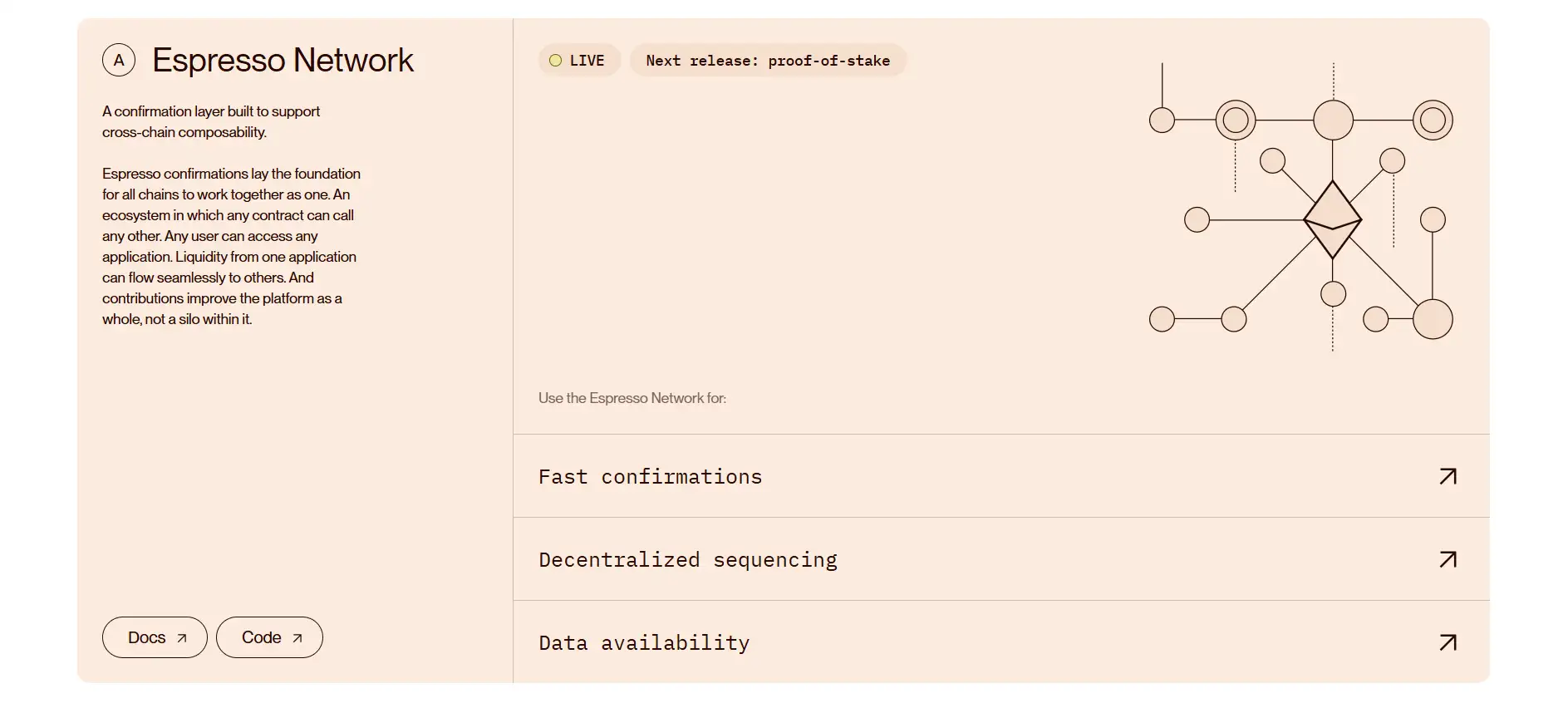About Espresso Sequencer
Espresso Sequencer is a pioneering infrastructure layer designed to enhance cross-chain composability and scalability across modular blockchain ecosystems. Built by Espresso Systems, the project aims to unify the fragmented blockchain environment by delivering a confirmation layer that enables chains to interact seamlessly with one another. Its vision is to create a network where any smart contract can communicate with any other, liquidity flows naturally, and applications are no longer siloed by their chains of deployment.
At its core, Espresso Sequencer provides fast, decentralized confirmations that serve as the foundation for synchronous and asynchronous messaging across rollups. By integrating technologies such as BFT consensus and supporting ecosystems like Arbitrum, OP Stack, and Polygon CDK, the platform stands as a future-ready solution for shared sequencing, data availability, and secure bridging. Espresso is reshaping what’s possible in the modular blockchain world by removing latency barriers and empowering developers with composable infrastructure.
Espresso Sequencer represents a significant evolution in blockchain infrastructure, primarily focused on solving the limitations of modular blockchain architectures such as fragmented liquidity, delayed finality, and disjointed user experiences. Through its live mainnet (currently Mainnet 0.0), Espresso introduces a live confirmation layer that enables fast, reliable cross-chain confirmations without compromising decentralization. These confirmations are powered by HotShot—a Byzantine Fault Tolerant (BFT) consensus protocol designed specifically for this purpose.
One of the central ideas behind Espresso is to allow multiple chains to behave as if they were part of one unified system. This architecture enables synchronous composability, wherein smart contracts across different chains can interact atomically. Espresso’s role is to provide the cryptographic guarantees and data availability necessary to make such interaction seamless, fast, and secure. The system supports various forms of modular integration, including support for chains like Arbitrum Nitro, Optimism Stack, Polygon CDK, and others, offering broad composability across Layer 2s.
Moreover, Espresso provides the technical foundation for shared sequencing markets. Chains can opt to sell sequencing rights in an open marketplace, allowing builders to schedule cross-chain transactions and achieve atomic execution. This concept facilitates the development of a new kind of ecosystem—one where liquidity and logic flow freely across chains, leading to a more unified user experience.
Espresso also supports a data availability layer called EspressoDA, and it is compatible with other DA systems like Celestia, EigenDA, and Avail. These integrations allow for flexibility while maintaining reliability and decentralization. Competing or comparable platforms include Fuel for modular execution, Polygon for zk scalability, and Optimism for Layer 2 deployment and governance.
Espresso Sequencer offers numerous benefits and features that address the core challenges of modular blockchain design:
- Fast Confirmations: Chains using Espresso benefit from near-instant confirmations, far quicker than Ethereum L1’s ~15-minute finality.
- Decentralized Sequencing: Rollups can decentralize transaction ordering by selling sequencing rights in a permissionless marketplace.
- Cross-Chain Composability: Supports both asynchronous and synchronous smart contract interactions across chains, enabling unified application logic.
- Broad Integration Support: Native compatibility with ecosystems like Arbitrum, OP Stack, and Polygon CDK streamlines adoption.
- Data Availability: Provides a built-in DA layer and supports external DA networks like Celestia and EigenDA.
- Secure BFT Consensus: Built on HotShot, a high-performance consensus mechanism tailored for fast, safe confirmations under real-world conditions.
- Permissionless Future: While the network is currently permissioned, an upcoming upgrade will introduce proof-of-stake and open validator participation.
Getting started with Espresso depends on your role in the ecosystem—whether you’re a chain developer, node operator, or dApp user:
- Developers Building Chains: Visit the official Espresso documentation to integrate Espresso confirmations. Integration supports Arbitrum Nitro, OP Stack, and other frameworks.
- Node Operators: Experienced infrastructure operators can join the permissioned network and prepare for future proof-of-stake validation. Express interest by visiting the Espresso website and submitting a form.
- dApp Users: If you use a chain or application integrated with Espresso, you already benefit from its fast confirmations. If your favorite dApp is not integrated, consider requesting it via social media and tagging Espresso.
- Explore the Ecosystem: Follow new integrations, partnerships, and research through the Espresso blog and resources.
- Community & Support: Stay informed and get help by subscribing to the newsletter or joining the Espresso discussion forums available on the Espresso Systems site.
Espresso Sequencer FAQ
Espresso Sequencer introduces a novel protocol called CIRC (Coordinated Inter-Rollup Communication), which enables synchronous composability across L2s without requiring any changes to their virtual machines. This means chains don’t need to compromise their architecture or upgrade their execution environments. Instead, CIRC works by providing fast, cryptographically verifiable cross-chain messaging powered by Espresso confirmations. The result is a system where smart contracts can interoperate across rollups as if they’re on the same chain — all while preserving modular independence. Learn more via the official Espresso Systems website.
HotShot is the high-performance BFT consensus protocol behind the Espresso Network. It enables the platform to offer strong, decentralized confirmations within seconds, even across multiple chains. This is critical for modular blockchains where speed and reliability are essential for cross-chain execution. Unlike traditional consensus models, HotShot is optimistically responsive, meaning it maintains speed under normal conditions without sacrificing security or decentralization. It underpins Espresso’s ability to coordinate state between chains in near-real time. Explore more at the Espresso official website.
Yes. Espresso is built to be modular and flexible, which allows rollups to integrate its confirmation layer without abandoning their existing infrastructure. Many rollups currently use centralized sequencers, but by adding Espresso, they can offer their users fast, decentralized cross-chain confirmations. This hybrid model improves the user experience without forcing projects to fully decentralize sequencing — making it easier for them to adopt gradually. More information is available at the Espresso Systems site.
Espresso supports a marketplace design where builders can purchase sequencing rights across multiple rollups simultaneously. This allows them to coordinate transactions atomically — a critical feature for executing user intents that span several chains. By leveraging this shared sequencing capability, builders can ensure guaranteed execution across chains within a single confirmation window. This solves a major challenge in the cross-rollup composability space. For further technical insight, visit the Espresso website.
Modular compatibility in Espresso’s design refers to its ability to interoperate with a wide range of chain infrastructures and data availability (DA) layers without imposing strict dependencies. Chains using DA systems like Celestia, Avail, or EigenDA can still use Espresso’s confirmation layer. This ensures that chains retain full control over their execution, DA, and sequencing choices while gaining the benefits of fast, decentralized cross-chain confirmations. Learn more on the Espresso site.
You Might Also Like












